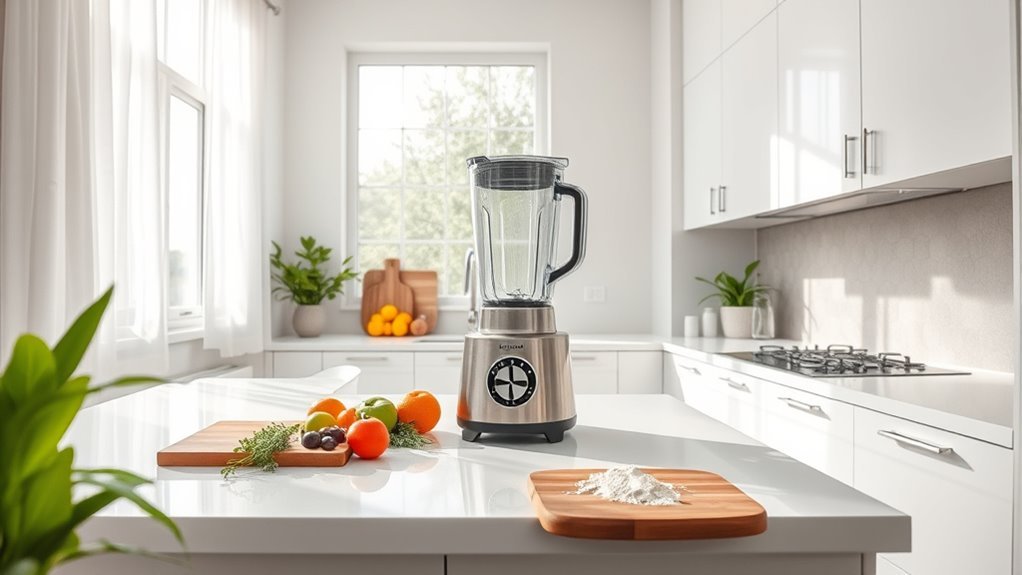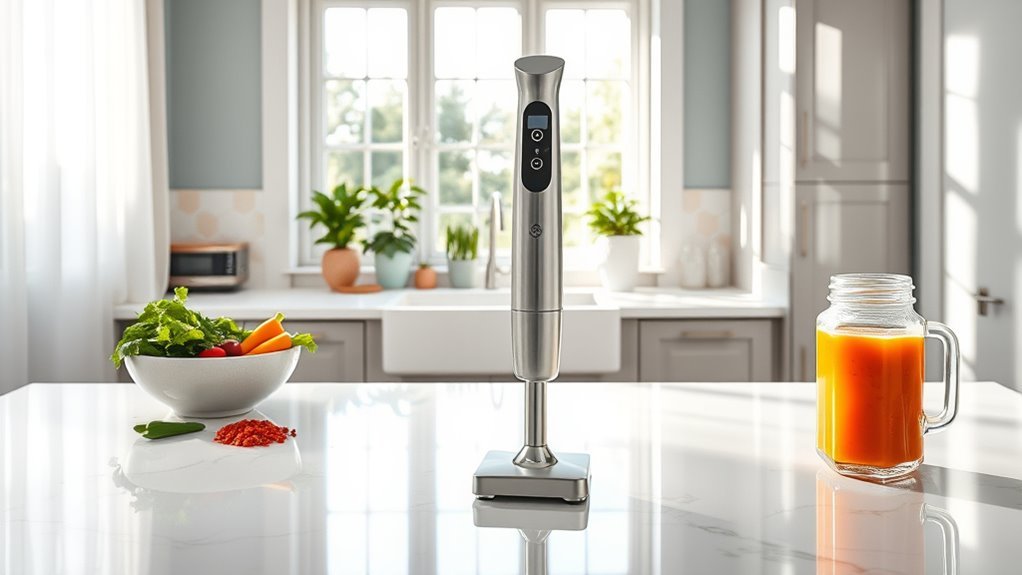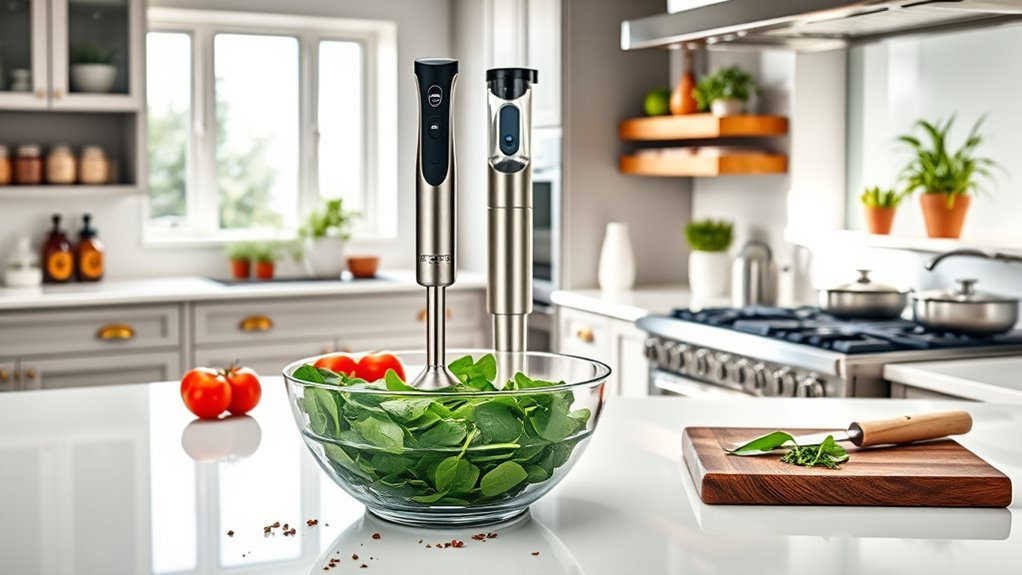When we’re choosing between blenders, the price tag is often our first consideration. We’ve found that immersion blenders typically start around $17 and rarely exceed $165, while countertop models range from $30 to well, let’s just say some premium options might cost as much as a decent smartphone. But is paying more actually worth it? The answer isn’t as straightforward as you might think, especially when we consider what you’ll actually use it for.
Initial Purchase Price Range Comparison

The price tag on blending equipment can be a make-or-break factor when you’re setting up your kitchen.
When we compare small appliances like hand blenders and countertop models, there’s a notable difference in investment.
Immersion blenders (also called stick blenders) are generally more budget-friendly, typically ranging from $17 to $165. The Amazon Basics model at just $35 is a perfect example of an affordable entry point.
In contrast, countertop BLENDERS start around $30 for basic versions but can quickly climb to $300-$800 for more powerful professional models. I think this price gap explains why many first-time kitchen owners start with an immersion blender – they’re simply more accessible when you’re watching your wallet but still want something functional.
However, countertop blenders that fall into the higher price range often include high-performance blenders, which are more durable and efficient for frequent use.
Long-Term Value and Durability Assessment
When buying kitchen equipment, we’ve got to evaluate more than just the sticker price.
In our lab testing of various models, we found that the All-Clad immersion blender offers decent longevity for occasional use, starting around $30 with a limited lifetime warranty.
For heavy daily use, though, countertop blenders with their incredibly powerful motors often justify their higher price tags.
The Breville Control Grip immersion blender, which is easy to use and has dishwasher-safe parts, only comes with a 1-year warranty—something to evaluate for long-term value.
Power matters tremendously.
Most immersion blenders we tested, like the 600-watt All-Clad, handle simple tasks well but may struggle over time, while countertop blenders are built with durability in mind for those fibrous ingredients you blend regularly.
High-performance countertop blenders can offer motor power exceeding 1,000 watts, providing greater reliability for intense, daily blending tasks.
Power vs. Price: Performance Metrics Analyzed

How much power does your money actually buy when comparing these two blender types?
We’ve found that immersion blenders offer impressive bang for your buck.
A powerful handheld blender like the Vitamix at $165 delivers 625 watts—plenty for soups and sauces—while the Amazon Basics model provides 500 watts for just $35!
In contrast, countertop models demand a steeper investment, with the KitchenAid K400 starting at $200 for its 1,000+ watts.
Where countertops shine is crushing ice and fibrous greens.
Every blender we tested over $300 with 1,000+ watts handled these tasks flawlessly.
Immersion models, even with variable speeds, simply can’t match that performance.
But honestly, do you need that much power?
For daily blending needs, a good $50-100 immersion blender’s motor base provides perfectly adequate speed.
Versatility and Function Cost Breakdown
Breaking down the versatility-to-cost ratio reveals surprising value differences between these kitchen workhorses. Stick blenders offer impressive functionality, with models like All-Clad delivering variable speed control and a blending arm that reaches directly into pots for under $100.
We’ve found that immersion blenders with a whisk attachment and speed settings between $50-$100 often provide better value than entry-level countertop models. For example, you’ll get similar blending capabilities for soups and sauces at half the price!
While powerful blender countertop models excel with their variety of accessories and food processor capabilities, they demand a significant premium—sometimes $300+ for features you might rarely use.
The sweet spot? A mid-range immersion blender around $75-100 that handles 90% of everyday blending tasks without breaking the bank.
Space Efficiency and Storage Considerations

Where you store your blender might be just as important as what it can do.
In small kitchens, space is premium real estate, and immersion blenders definitely win this competition.
These stick blenders are easy to maneuver and can be used directly in the bowl, eliminating the need for additional blending jars.
Storage advantages of immersion blenders include:
- They fit neatly in kitchen drawers, unlike countertop models
- A hand blender weighing only 2.8-4.1 pounds can be stored vertically in tight spaces
- No need for permanent counter space, making them ideal for smaller containers
- Some cordless models offer even more flexibility for storage
We’ve found that immersion blenders greatly reduce kitchen clutter while countertop blenders with their bulky blending jar often demand dedicated space—something many small kitchens simply can’t spare.
Attachment and Accessory Expenses
When it comes to the complete cost of owning a blender, we’ve got to look beyond just the sticker price. Attachment expenses can really add up!
Many immersion blenders (or hand blenders as some call them) actually give you more bang for your buck in this department.
For instance, the Amazon Basics and Breville Control Grip models come with whisk attachments, chopper attachments, and blending jars included.
Compare that to many countertop or personal blenders that might require you to purchase blender jars or a blending cup separately.
Sure, high-end options like the Vitamix Immersion Blender or All-Clad mightn’t include everything, and KitchenAid’s Smart Stick might tempt you with expansion packs. But generally, we’ve found immersion blenders tend to bundle more accessories upfront, saving you from those sneaky additional expenses down the road.
Energy Consumption and Operating Costs
Let’s shift our focus to the operating costs after purchase—specifically, how much electricity these appliances guzzle.
When comparing energy consumption, immersion blenders like the Foodi Power variable speed hand models are considerably more efficient.
Here’s what we’ve found:
- Wattage differences – Immersion blenders typically run at 280-625 watts, while countertop models often exceed 500 watts for identical blending jobs
- Daily usage costs – A 600-watt immersion blender costs roughly $0.07-$0.10 per use at average electricity rates
- Annual expenses – Expect to pay $5-$15 yearly for immersion blenders versus $20-$50 for countertop models
- Performance efficiency – Though powerful blending sometimes took longer with hand blenders, the energy saved while preparing hot soups directly in pots offsets this extra time
Even with at least a few speed options, those spinning blades use less juice!
Maintenance and Replacement Part Expenses
Though you’ll eventually need to replace parts in any kitchen appliance, the maintenance costs between our two blender types couldn’t be more different.
Immersion blenders win hands-down in this category.
We’ve found they’re incredibly simple to maintain—just run the blending head under soapy water after use.
Many models have dishwasher-safe blending attachments with a blade guard to prevent damage.
Countertop blenders, well, they’re a bit more demanding.
You’ll need to disassemble multiple parts, and their complex motors tend to wear out faster.
We particularly like how immersion blenders with plastic or silicone blades at the end won’t scratch the bottom of the pot.
Plus, with warranties like All-Clad’s lifetime coverage, you might save $10-$50 annually compared to countertop models that need more frequent part replacements.
Frequently Asked Questions
What Are the Disadvantages of an Immersion Blender?
We’ve found immersion blenders have significant power limitations, capacity limits, and splash hazards. They struggle with ice, create mess, and lack versatility for larger recipes compared to countertop models.
Is a Countertop Blender Better Than a Blender?
Countertop blenders offer higher blending speed and motor power, delivering superior result quality. However, we’ve found immersion blenders excel in operation ease, cleaning process, and price value, while using less counter space and energy.
Are Immersion Blenders as Good as Regular Blenders?
No, immersion blenders aren’t as good as regular blenders. They offer less power output, blending efficiency, and versatility factor, though we appreciate their user comfort, cleaning ease, and minimal storage space requirements.
What Are the Benefits of a Portable Blender Compared to an Immersion Blender?
Like pocket-sized kitchen wizards, portable blenders offer travel ease with battery power and cordless operation. We love their space savings, lightweight design, compact storage, and on-the-go mixing capabilities for quick prep during our busy lives.

